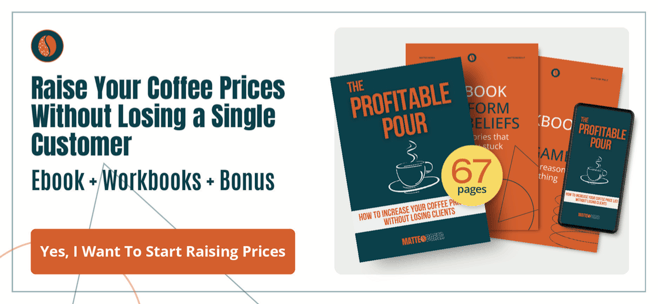Price Hikes Aren’t the Problem. Your Words Are.
Why smart coffee businesses use language to position themselves, not to justify themselves.
COFFEE MARKETMARKETING
Raising prices is a natural step in any coffee business. Costs evolve, quality improves, and the market shifts.
And yet, most entrepreneurs still treat it like something shameful. They write signs that apologize. They blame external forces: raw material shortages, energy spikes, inflation. As if saying “It’s not our fault” will soften the blow.
But this kind of messaging creates a dangerous disconnect. It focuses on the problem instead of the value.
It positions the business as a victim of circumstances not as a confident, evolving brand that adapts with purpose. And that’s where the real issue lies.
When price becomes a reaction instead of a decision, strategy disappears. There’s no narrative, no leadership, no message of growth. Just fear and justification. And in a world where change is constant and adaptation is essential, this reactive approach doesn’t just miss the opportunity, it undermines it.
Instead of embracing the moment to communicate innovation, quality, and long-term vision, many coffee entrepreneurs fall into the trap of defending their choices. They forget that pricing isn’t just a number, it’s a signal. And how that signal is framed says everything about the maturity of the business behind it.
When a coffee business communicates a price increase without intention, the message backfires. Not because people hate paying more but because they don’t understand what they’re paying for.
If all the customer hears is “prices are going up due to rising costs,” their mind automatically links the higher price to lower value. Same product, same service, just more expensive. No innovation, no growth, no added experience, just inflation passed down the line.
This is where trust erodes.
What should be a moment to reinforce your positioning becomes a signal of weakness. Instead of showcasing your evolution as a brand, you sound like you’re struggling to survive. And in the long run, that kind of narrative kills loyalty, especially in a competitive market where the customer is constantly choosing between options.
More dangerously, this reactive mindset can spread inside the business. Team morale drops. Pride in the product fades. The business stops being a place of change and strategy, and becomes a place of compromise and excuses. Every decision becomes tactical, not strategic.
In short: when you fail to control the message, you lose control of the perception. And in the coffee business, where experience, quality, and emotion are everything, perception is the true product you’re selling.
Price increases aren’t the problem. The real problem is how they’re framed.
Instead of justifying the numbers, use them as a chance to tell a better story, one that reinforces your values, your standards, and your vision. This isn’t about spin. It’s about ownership. It’s about making sure every message your business sends is aligned with who you are and where you’re going.
A price adjustment should reflect a strategic decision, not a defensive reaction. If you’re charging more, it’s because you’re delivering more: better quality, more attention to detail, a deeper commitment to sustainability, service, or innovation. That’s the story. That’s what people need to hear.
In a modern coffee business, communication is not decoration, it’s infrastructure. It’s how you build trust, authority, and emotional connection. And in a landscape where growth depends on brand perception as much as product quality, your words are assets. Treat them as such.
This is where adaptation becomes a competitive edge. Businesses that thrive are not the ones with the cheapest espresso, but the ones who know how to turn every decision — including pricing — into a clear, confident expression of their identity.
You’re not just raising prices. You’re leading a shift. Show that.
Every time you adjust a price, you’re not just changing a number, you’re sending a signal. And that signal either builds trust or breaks it.
In a world where attention is short and competition is fierce, the businesses that stand out are not always the ones with the best product, but the ones who know how to communicate with clarity, consistency, and intent. Strategy is not just what you do, it’s how you explain what you do. Especially when the stakes feel uncomfortable.
So the next time you find yourself about to type “Due to rising costs…”, pause. Ask yourself: is this a message of fear, or a message of leadership?
Because if you want your customers to see your value, you have to speak it first.




